Richard Misrach, Stranded Rowboat, Salton Sea, 1983. Photographs from the Martin Z. Margulies Foundation Part II.
Any architect will tell you that buildings are in a perpetual state of deterioration. From the moment they’re erected, they’re in the process of failing, seeming to collaborate with both forces of nature and the impacts of human presence. The earth shifts, buildings settle, and like a garden, the constructed networks of buildings and infrastructure require human intervention to avoid decay or overgrowth. In this sense, the built environment merges with the natural one, and to gaze across it is to see the vestiges of a manufactured ecosystem, piecing together which parts have been cultivated and which have been forgotten.
For this reason, photography’s unique ability to capture a single moment in time offers us a glimpse of this inherently human process as it unfolds. After all, construction systems require many societal inputs, from architects to businesses, buyers, renters, designers, governments, investors, laborers, and more. Viewing such works is to glimpse the impacts and impressions left on nature by these social roles, proving that architectural and structural photography is, in fact, human photography.
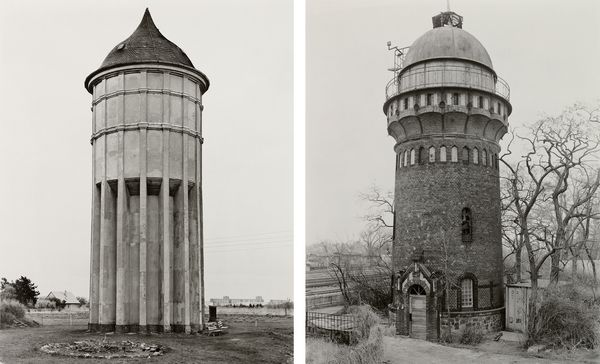
(Both) Bernd and Hilla Becher, Left: Wasserturm Leipzig D (water tower), 1998. Right: Wasserturm/Magdeburg D (water tower), 1995. Photographs from the Martin Z. Margulies Foundation Part II.
Within the Martin Z. Margulies Foundation Collection, a curatorial commitment to artistic depictions of the built environment allows us to focus on these ideas in more ways than one. This selection — coming to auction on 9 October at Phillips — is not mere documentation; it explores the cultural and sociological implications of the spaces in which we live and work and the physical and ideological structures we come together to build. These works challenge us to rethink how we see and consider the world we’ve built and its impact on the environment we’ve inherited, lest we allow it to decompensate. And there’s perhaps no better location or photographer for which to begin considering these issues than the city of Detroit, Michigan, and the pioneering artist Stan Douglas.
Stan Douglas and Detroit
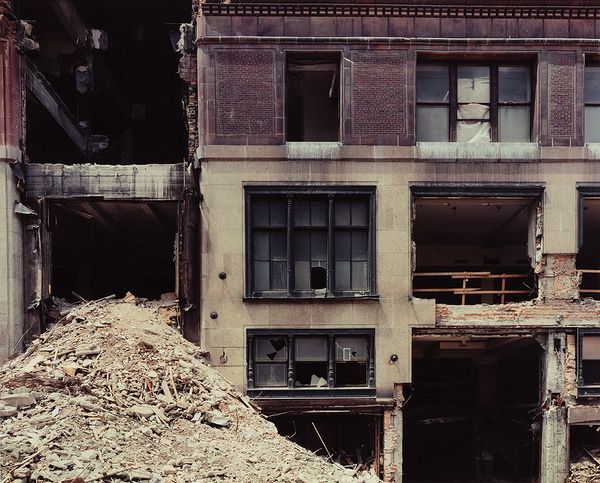
Stan Douglas, From Detroit Photos, 1997–1998. Photographs from the Martin Z. Margulies Foundation Part II.
In his Detroit Photos series, Douglas freezes his vision of the city’s urban decay across 18 months from 1997 to ’98. The artist is well known for exploring modernity’s impact on collective memory, so it follows that Detroit would be a fertile subject for him — when we listen to the political rhetoric in America today, we realize that the auto industry’s boom era, and thus Detroit’s fortune and unraveling, is a canonical myth in the American collective consciousness.
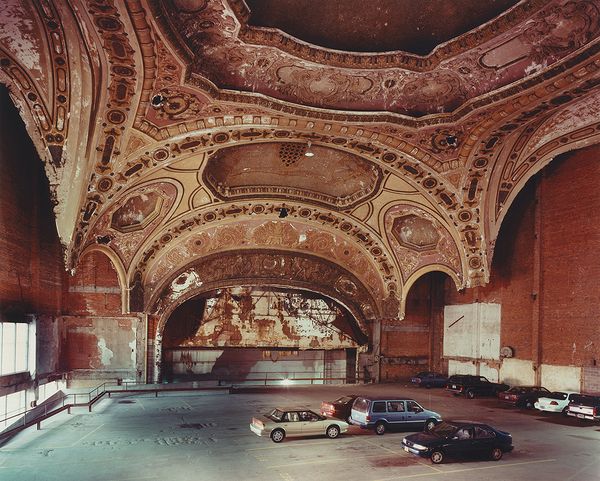
Stan Douglas, From Detroit Photos, 1997–1998. Photographs from the Martin Z. Margulies Foundation Part II.
Across these works, we see empty streets, partially collapsed buildings, shuttered businesses, and abandoned construction sites in the structural remnants of a previously thriving society. Detroit had seen several prosperous decades since the end of the Second World War, but urban infrastructure began to decline in the 1960s and ‘70s as investments in suburban developments increased, urban demographics shifted, manufacturing plants closed, and municipal tax income dwindled.
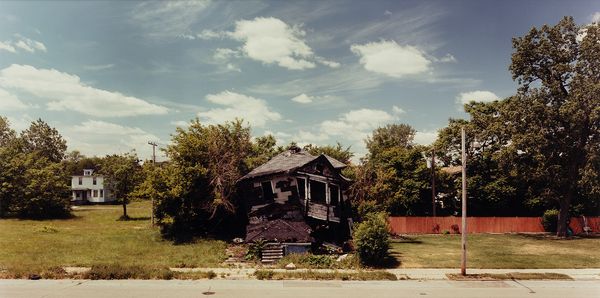
Stan Douglas, From Detroit Photos, 1997–1998. Photographs from the Martin Z. Margulies Foundation Part II.
By the time Stan Douglas captured these photographs, the impact of decades of structural decay could be seen in Detroit, exacerbated by the economic uncertainty that rippled through global markets in 1997 and ’98 and the local tornados in 1997. But through these occasionally devasting scenes, we can hold an array of responses. In addition to the story of how society has failed Detroit, we’re also left with the impression of the community’s determination to find the best way of life in the face of adversity. These images continue to resonate today, as issues around the preservation of built environments have been of crucial cultural relevance as we discuss ideas of community, migration, isolation, gentrification, and equity.

Stan Douglas, From Detroit Photos, 1997–1998. Photographs from the Martin Z. Margulies Foundation Part II.
Thomas Struth and the Ruhr Valley
In many ways, the people of Detroit are the subjects of Douglas’ photographs, even though they are not seen. This approach echoes that of German artist Thomas Struth in the series Unconscious Places. Taken in Germany’s Ruhr Valley, these photographs also showcase empty streets but call to mind the humanistic aspects of such constructed environments. Like Detroit, the Ruhr Valley is an industrial region, but one that was reconstructed in the decades following the Second World War, around the time Detroit was experiencing its first major economic boom and the resulting proliferation of construction.
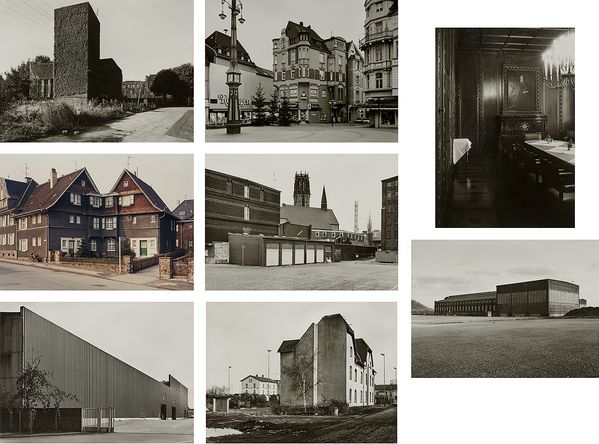
Thomas Struth, Selected Images of the Ruhr Valley from Unconscious Places, 1984–1989. Photographs from the Martin Z. Margulies Foundation Part II.
Struth studied with Bernd and Hilla Becher, cultivating a disciplined practice that emphasized photographic precision and detailed documentation of the world. But Struth’s approach here widens this scope conceptually, approaching the street as a universal communal site in the modern world and raising questions about how these environments come to be. Struth has explained, “As to the title, Unconcious Places, I have always wanted to explore our common responsibility. On what level are we all responsible for letting it happen?”

Thomas Struth, Selected Images of the Ruhr Valley from Unconscious Places, 1984–1989. Photographs from the Martin Z. Margulies Foundation Part II.
Ed Ruscha and Southern California
Seen through the lenses of observant artists, imagery of the built environment highlights the inner workings of our culture, and in considering these works, curious realities emerge. For instance, when we view such images in an urban gallery, we become aware of our place within them. In this sense, art cannot escape the built environment — it’s either displayed inside of it or, in the cases of public sculpture or land art, it becomes a part of it. What’s more, our eyes must wrestle with the antinomy between the complex social challenges implied by many of these works and the visual pleasure derived from the fact that they’re so captivating when considered as pure images.
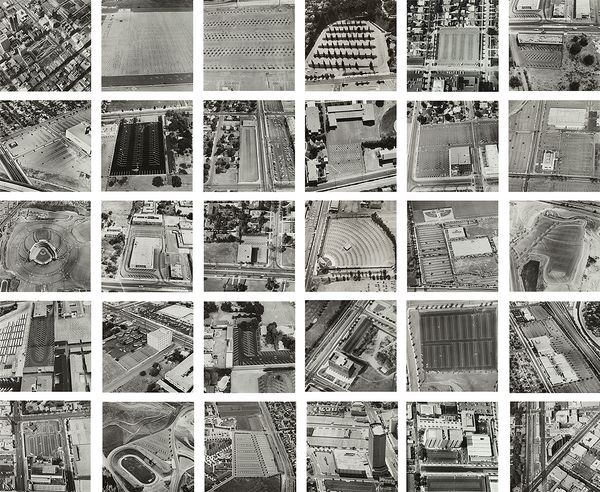
Ed Ruscha, Parking Lots, 1967. Photographs from the Martin Z. Margulies Foundation Part II.
Take Ed Ruscha’s early photographs of parking lots in Southern California, for example. Taken from a helicopter one morning in 1967, these aerial photographs focus on primarily empty parking lots, emphasizing the pure geometry of Southern California’s built environment from a rarely seen vantage point. These remarkable early works demonstrate the artist’s interest in the physical structures of urbanity that he has since continued to explore in iconic and deadpan depictions of gas stations, vacant lots, cars, and text. As much as Parking Lots highlights the trappings of American life through car culture, baseball, consumerism, and mass media, the works also freeze a moment in the growing urban sprawl of the American West that continues today.
Olafur Eliasson and Iceland
Built environments are not always urban and dense. Sometimes, they demonstrate a cultural need for life to be more closely integrated with the natural environment. For this, look to the grid of 56 images of remote Iceland captured in Olafur Eliasson’s The hut series. With these works, Eliasson continues his earlier exploration of the natural environment of his native country, but here, he turns the lens to small structures that are dwarfed by the colossal surrounding landscape.
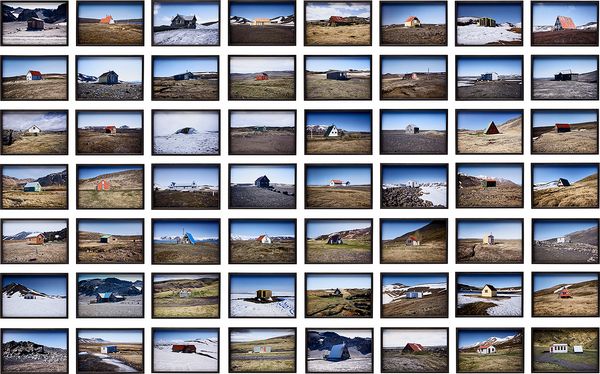
Olafur Eliasson, The hut series, 2012. Photographs from the Martin Z. Margulies Foundation Part II.
Though these placid images showcase comfortable communal environments intended for farmers and transient visitors, the artist’s choice to photograph these subjects in the transitional spring season calls to mind the fact that built structures, our own lives, and the natural world are in constant flux. Indeed, if more drastic measures are not taken to protect our environment, in a few decades, it may be difficult to tell which season this image was captured, as we may see melting snow at points throughout the year. Eliasson is aware that our ecosystem and climate are as fragile as the buildings we construct, and he takes these considerations seriously in his art and his work as a Goodwill Ambassador for the United Nations.
Across these photographs, what is perhaps most striking is how transient the built environment can be and how powerfully the medium’s temporal nature meets that fact. They not only serve as documents of the physical structures of society at a fixed point in time but also the stratified construction of society itself. What’s so captivating about them is that the images can remain fixed while our understanding of them will continue to be informed by cultural and structural developments worldwide.
Discover More from Photographs from the Martin Z. Margulies Foundation Part II >
Recommended Reading
Specialist Picks: Photographs New York >
A Way of Life: The Martin Z. Margulies Foundation Collection >
